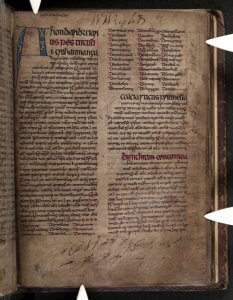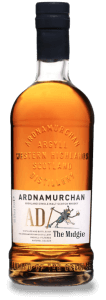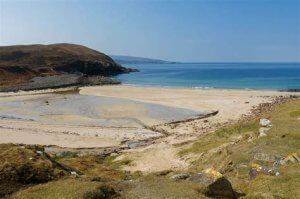The Weekly Mash, Friday June 5th
Welcome, friends to the latest musings which this week have been triggered by a seasonal bottling from the SMWS as we bid farewell to spring, and a new arrival from Ardnamurchan announcing the arrival of the midges. There’s thoughts on mediæval physicians, ruined holidays, the dread return of Liz Truss (a midge in human form) and the delights of Adrian Crowley’s music.

The Last Breath of Spring

Here in the north, meteorological summer began on June 1, which in turn means bidding a sort-of farewell to spring-like drams. That said, at the moment the rain is stotting off the pavement and I’m contemplating lighting the fire – conditions more suggestive for the drinking of deep, sherried drams.
Still, after they read the first Weekly Mash which talked of the idea of seasonal drinking, the kind souls at SMWS sent down a bottle of 72.125 ‘Blossom Reverie’ for my perusal. To hell with the weather, let’s get stuck in. Part of the Society’s ‘Whispers of Spring’ series, it started from a vatting of some 28yo casks which were then given a further year in a refill Bourbon hoggie, resulting in a 29 year old, at 49.1%, with a price tag of £245.
The autumnal weather is forgotten immediately. This is vibrant, even still slightly green. There’s flowers galore (night-scented stock, dog rose, gean, jasmine) with a dry honey back note. Though you could say the aromas are in the light spectrum they are intense and penetrating – a cottage garden in early morning garden after a shower, sun coming out. Things become slightly more powdery with water, adding pollen, chamomile and a little apple syrup.
It floats over the top of the palate, but there’s just enough of that syrup/honey to stick it to the tongue. It benefits from a drop or two of water, which reinforces the idea that there’s been no loss of energy after almost 30 years. The ‘green fuse that drives the flower’ at play.
The Society has adopted a clever and sensible practise of using flavour profiles to help members navigate what is an enormous range. This, as you might guess, is in its Light & Delicate category. It’s an approach that makes a lot of sense. Whisky is scary. How do you navigate a wall of green bottles with codes on them? Anyway, people buy by flavour.
The first question to ask a new whisky drinker isn’t ‘what dram would you like?’, but ‘what do you normally drink?’. The answer gives you an idea of their palate preferences: light and delicate fits with Riesling, Sauvignon Blanc, Pinot Gris/gio, IPA etc.
Light can be, wrongly, used disparagingly – a substitute for ‘bland’ or ‘one-dimensional’. This is far from the case. Lighter, spring like, ‘whispering’ [©Martine Nouet] whiskies may not win many competitions, but how can you assess nuance and subtlety when you have to get through 80 samples in a morning? Spring-like whiskies are hugely rewarding. Right time, right place, right company.

72 is the SMWS code for a Moray distillery which sits close by Pluscarden Abbey. Monasteries crop up frequently in the tale of whisky’s apparent origin, which tells accounts of monks bringing the secrets of distillation to Scotland, then keeping that knowledge behind their walls until the Reformation when it was finally allowed to spread across the wider community. A nice story, but untrue.
Aqua Vitae/Uisce Beatha started life not as a cereal-based distillate but a spirit made from wine distilled with herbs to be taken as a medicine. The first who practised the art weren’t monks, but mediæval physicians. If you are looking at the pre-history of whisky, you must first turn to Ireland. Last year, I visited the Royal Irish Academy in Dublin with historian Fionnán O’Connor to study a mid-15th century book about the virtues of distilled spirit which contains the first-known use of the term uisce beatha. It follows Tadhg Ó Cuinn’s ‘Materia Medica’ (1415) which not only lists the curative properties and uses of local plants, but contains an essay on the uses of aqua vitae.

Many of the Irish medicinal brotherhood (ollamháin) had either studied in the medical schools of Salerno and Montpelier, or worked from the texts generated there which were then translated into Irish. One branch, the MacBeathas, moved to Islay in the 14th century and, by then known by the name Beaton, spread across western Scotland, and to the Royal court. They, conceivably, brought the knowledge of distillation to Scotland. Its first distillers? We don’t know. But they weren’t monks. They were physicians.
By the time Hector Boece was writing his, occasionally fantastical, ‘History and Chronicles of Scotland’ in the 1520s, he was speaking of when his ancestors, ‘were determined of a set purpose to be merie, they used a kind of aqua vite [sic], void of all spice, and onelie consisting of such herbs and roots as they grew in their own gardens…’ This not only shows that spirits were becoming social drinks by the 16th century, but that their roots in the physic garden remained.
What would have been happening at Pluscarden? Beer possibly, but distillation? Unlikely. What we can do though is drink the whisky made next to its grounds and imagine spring.
—————

In my Glass: Midges
The midge is a tiny beastie consisting of naught but teeth and bad attitude that, each summer in Scotland, emerges in clouds, hungry and angry. They are the cause of ruined holidays, the destruction of idyllic days out, and abandoned romantic marriage proposals. It has been posited that some of the moves in Scottish country dancing are derived from the actions of someone fighting off a violent midge attack.
Imagine the scene. It’s your first summer holiday in Scotland. It’s late in the day, the sun is easing its way towards the horizon, the air is soft and slightly humid, the breeze has dropped. Time for taking a drink outside and enjoying the gloaming. The naive fools who embark on this course of action will soon be slapping and shrieking as the horde of vengeful mites descends, chaos on their hive mind.
Meanwhile, experienced locals will either retreat indoors and gaze at the sunset through the windows, or start slapping on Smidge, the repellant of choice. Folk remedies may also be tried: a garland of bog myrtle, cigar smoking, or dabbing whisky behind the ears (it has been know in extreme cases for entire bodies to be doused in clearic).

Now, the Islay midges are nippy, but those of Jura are worse. Glencoe’s cluster in such density that you can choke on them, while those around Loch Sunart are particularly vengeful. I recall that on a hike there once, we were clad like ninjas to keep the malign swarm at bay.
Connoisseurs will grade midges by place and viciousness. I consulted my old friend and noted midge expert the poet Douglas Lipton for more on this, specifically with regard to those from Ardnamurchan. ‘The midges of Ardnamurchan – from my recollection – are bad,’ he replied, with a shudder, ‘but they pale into relative minor pestilence when compared to those of the Aultbea area – Slaggan Bay, in particular, about which [our mutual friend] Michael Warren published an account.’ If Slaggan Bay is a 10 on the Warren Scale, then Ardnamurchan is a good 8.

In case you’re wondering, this is all relevant, as the good folk at the Ardnamurchan distillery have just launched this year’s AD/The Midgie (now available internationally). A vatting of 75% unpeated spirit and 25% peated, it comprises 50% ex-Bourbon barrels, 48% Port barriques and 2% sherry casks. It’s 48%abv, and costs around £50.
Blushing like a west coast sunset, there’s pink grapefruit, dried cranberry, fruit pastilles, pineapple and something akin to salted peaches. Light turfy smoke drifts into oxidised notes, and a cool, shoreline quality. Water brings out more of the Port, some Tokay-like nuttiness, marzipan, Jaffa cakes, and sour cherry.
The mouth is equally sweet to start, with the smoke building from mid-palate on, a bit like a dusting of smoked pimenton/pul biber. It has a supple feel, mixing aromatic woodsmoke, those oxidised fruits, saltiness, ripe pears and more of the marzipan. After lulling you in, the midges start their attack – giving the finish a nettly nippiness. It gets a big thumbs up.
Wear it if you wish, but I’d recommend that it be taken internally in whatever way you want – strong and neat, a drop of water, or as a Highball. But if being consumed outdoors in Scotland this summer watch out for a midge garnish.
—————

A-musing
I see that the dread spectre of Liz Truss has manifested once more, this time promoting an Irish whiskey owned by a bare-knuckle boxer fresh out of jail for assaulting a pensioner.
Liz managed to trash the economy, and kill the Queen but was defeated by a courageous lettuce before she could do any more damage. She now appears to be turning her basilisk sights on Irish whiskey. For once I’m not in the least concerned about the harm her appearance will do to this brand, but I do worry about any collateral damage to the wider industry. Be afraid my friends, be very afraid.
—————

In My Ears
A lovely gig from Adrian Crowley the saturnine songwriter/poet from Dublin whose work speaks of a world lit by dark blue tones. Less songs and more like short stories or poems set to music with each word carefully placed. Birds feature strongly in his crepuscular world. In some weird synchronicity as I write this, starlings are flying past the window, buffeted by the dying gale, murmuring in the sky.
There’s a pot of Oolong on my desk. Its roasted bittersweet chocolate nuttiness and light grip seem to suit the darkening sky and flickering birds. It’s not all whisky here you know. More on tea and its connections to whisky soon I think
Dip into Adrian Crowley’s new album here … and also go through his back catalogue.
Catch you next week. Take care.